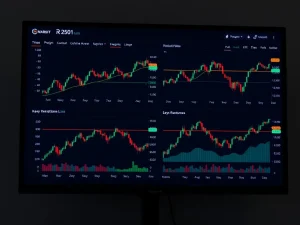Ethereum ETFs Witness Remarkable $457M Rebound in Digital Asset Investment

The cryptocurrency market is buzzing with renewed optimism as recent data reveals a remarkable surge in institutional interest. After a period of heightened volatility, Bitcoin and Ethereum ETFs have collectively attracted a staggering $457.84 million in net inflows on Thursday, signaling a robust rebound. This significant influx highlights a pivotal moment for digital asset investment, demonstrating a growing confidence among major players in the traditional financial sector. For those keenly following the pulse of the crypto world, this development is a clear indicator that institutional conviction in digital assets is not just returning, but strengthening.
Ethereum ETFs Lead the Charge: A Closer Look at Recent Inflows
The spotlight is firmly on Ethereum ETFs, which have been on an impressive run, extending their streak to 15 consecutive days of net inflows. On Thursday alone, these products secured a substantial $231.23 million, contributing significantly to the overall market recovery. Leading the charge were Fidelity’s FETH and Grayscale’s ETHE, with FETH alone accounting for an astounding $210 million in single-day inflows. This consistent demand has propelled Ethereum ETFs’ cumulative net inflow to an impressive $8.88 billion. Currently, the total assets under management (AUM) in Ethereum ETFs exceed $20.7 billion, representing approximately 4.6% of Ethereum’s total market capitalization. BlackRock’s ETHA continues to dominate the landscape as the largest Ethereum ETF, boasting $10.49 billion in net assets, closely followed by ETHE and FETH. This sustained interest underscores Ethereum’s growing appeal as a foundational digital asset for institutional portfolios.
Bitcoin ETFs Show Resilience: What’s Driving the Renewed Interest?
Not to be outdone, Bitcoin ETFs also demonstrated remarkable resilience, reversing three consecutive days of outflows with a significant $226.61 million in net inflows. This marks the first significant reversal for Bitcoin-specific products, signaling renewed support from major providers. Fidelity’s FBTC and BlackRock’s IBIT were key contributors, attracting $106.58 million and $32.49 million, respectively. Cumulative assets in Bitcoin ETFs now stand at an impressive $154.45 billion, accounting for 6.54% of Bitcoin’s total market cap. BlackRock’s IBIT remains the flagship product, maintaining its dominance with $57.15 billion in cumulative inflows. This renewed momentum suggests that institutional investors are increasingly viewing recent market corrections not as risks, but as strategic entry points, a testament to Bitcoin’s enduring position as a store of value in the evolving financial landscape.
Understanding the Surge in Crypto Inflows: A Shift in Investor Sentiment?
The recent surge in crypto inflows into spot ETFs is more than just a fleeting trend; it represents a profound shift in investor sentiment and perception. For a long time, cryptocurrency markets were characterized by rapid booms and busts, often leading to panic selling during downturns. However, the current environment paints a different picture. Analysts attribute this change to growing institutional acceptance of crypto as a legitimate and tradable asset class. The presence of regulated, liquid ETF products significantly lowers the barriers for traditional investors, providing a familiar and secure avenue to gain exposure to Bitcoin and Ethereum. This surge in demand, particularly during a period that recently saw market uncertainty, indicates a structural shift in how crypto is perceived—from speculative gamble to a serious component of diversified investment portfolios.
The Growing Wave of Institutional Crypto Adoption: Why Now?
The increasing pace of institutional crypto adoption is a multi-faceted phenomenon driven by several key factors. Firstly, regulatory clarity, albeit still evolving, has provided a more defined framework for large financial institutions to operate within. The approval of spot ETFs in major markets has been a game-changer, offering a regulated product that fits existing investment mandates. Secondly, the maturation of the underlying blockchain technology and the growing utility of cryptocurrencies like Ethereum (with its extensive ecosystem) and Bitcoin (as a digital gold alternative) have made them more compelling long-term investments. Institutions are recognizing the potential for significant returns and diversification benefits that digital assets can offer. This strategic positioning, balancing risk management with long-term conviction, contrasts sharply with earlier market cycles and underscores a more sophisticated approach to crypto investment.
Navigating Digital Asset Investment: Opportunities and Outlook
The consistent inflows into spot ETFs are bolstering confidence in crypto’s legitimacy within institutional portfolios, fundamentally reshaping the landscape of digital asset investment. These products are not only lowering barriers but also acting as a stabilizing force for BTC and ETH prices, as investors increasingly treat price dips as opportunities to add to their positions rather than triggers for panic selling. This behavior signifies a maturing market, where strategic accumulation is replacing reactive selling. The trend highlights crypto’s evolving role in global finance, moving from the fringes to a more integrated position. With Ethereum ETFs maintaining a remarkable 15-day inflow streak and Bitcoin ETFs reversing recent outflows, the market appears to be entering a phase of selective accumulation and long-term positioning. This suggests a more stable and predictable growth trajectory for the leading cryptocurrencies, paving the way for broader acceptance and integration into mainstream finance.
Conclusion: A New Era of Confidence
The recent substantial inflows into Bitcoin and Ethereum ETFs mark a pivotal moment for the cryptocurrency market. This rebound in institutional interest, characterized by strategic accumulation rather than panic selling, signals a maturing asset class and growing confidence among major financial players. As regulated investment vehicles continue to bridge the gap between traditional finance and digital assets, the path for broader institutional crypto adoption seems clearer than ever. This trend not only validates the long-term potential of Bitcoin and Ethereum but also sets a precedent for a more stable and integrated future for digital asset investment within global portfolios.
Frequently Asked Questions (FAQs)
Q1: What are Bitcoin and Ethereum ETFs?
A1: Bitcoin and Ethereum Exchange-Traded Funds (ETFs) are investment vehicles that allow investors to gain exposure to the price movements of Bitcoin and Ethereum without directly owning the cryptocurrencies. They are traded on traditional stock exchanges, making them accessible to a broader range of investors, including institutions, who might prefer regulated products over direct crypto ownership.
Q2: Why are institutional inflows into crypto ETFs significant?
A2: Institutional inflows are significant because they represent large-scale investments from major financial entities like asset managers, hedge funds, and pension funds. Their participation lends legitimacy and credibility to the crypto market, increases liquidity, and can contribute to price stability. It signifies a growing acceptance of cryptocurrencies as a viable asset class within traditional finance.
Q3: What does ‘market correction as entry points’ mean?
A3: This phrase refers to a strategy where investors view temporary price drops or downturns (corrections) in the market as opportunities to buy assets at a lower price, expecting their value to increase over the long term. Instead of selling in panic during a dip, institutional investors are strategically accumulating more Bitcoin and Ethereum ETFs, indicating strong long-term conviction.
Q4: How do ETFs contribute to institutional crypto adoption?
A4: ETFs lower the barriers to entry for institutional investors by providing a regulated, familiar, and liquid investment product. They eliminate the complexities of direct crypto custody, security, and regulatory compliance, making it easier for traditional financial firms to integrate digital assets into their portfolios.
Q5: What is the current market capitalization percentage held by Bitcoin and Ethereum ETFs?
A5: As of recent data, Bitcoin ETFs hold approximately 6.54% of Bitcoin’s total market capitalization, while Ethereum ETFs hold about 4.6% of Ethereum’s market capitalization. These percentages highlight the substantial and growing influence of these regulated investment products on the overall crypto market.
Q6: What does the 15-day inflow streak for Ethereum ETFs indicate?
A6: The 15-day consecutive inflow streak for Ethereum ETFs indicates sustained and consistent institutional demand for Ethereum exposure. It suggests a strong underlying belief in Ethereum’s ecosystem and future potential, demonstrating that institutional investors are actively and continuously allocating capital to these products, even amidst broader market fluctuations.










